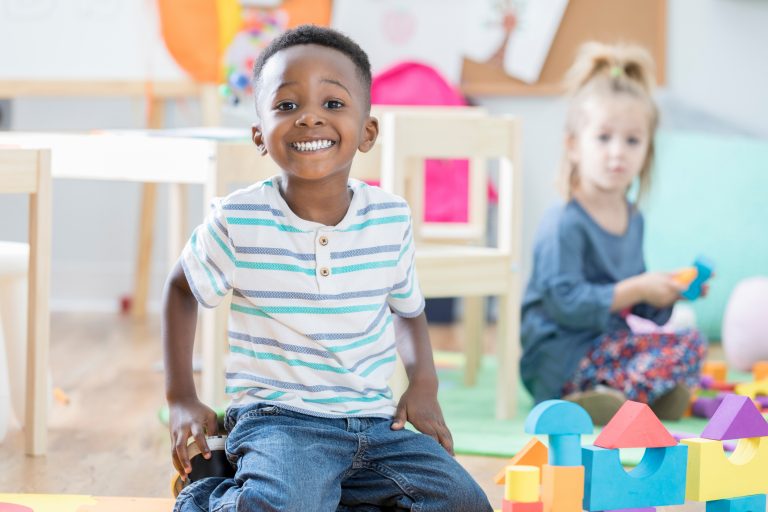Author Robert Fulghum spoke the truth with the phrase, “all I really need to know I learned in kindergarten.” Even so, he probably didn’t know it all on the first day.
While you realize that your child is going to learn many new things over the course of the year, you also want him to be as ready as possible. However, it’s been a while since you were in kindergarten, so how can you be expected to know what’s important? We’re taking the guesswork out of it and giving you a sneak peek into the skills and abilities kindergarteners need as they head into their first real classroom.
1. Be independent in the bathroom.
In addition to basic potty-training skills, your child should be able to do all the necessary clothing maneuvers (basically, pulling things down and then putting everything back where it needs to be). Especially in the early days, choose user-friendly clothes such as loose-fitting bottoms with an elastic waist. Avoid complicated outfits like overalls, one-piece jumpers or pants with a button and zipper.
Handwashing is going to be “the” must-have skill of the year, and for the foreseeable future. Make sure your child understands that 20 seconds of scrubbing are required – no shortcuts allowed. If needed, show them a kid-oriented handwashing video as a review.
2. Keep track of their belongings.
These days, it is more important that ever to avoid germy mix-ups of water bottles, outerwear, and other personal belongings. Keeping things organized may be a new concept for kindergarten rookies, so do a few trial runs at home where they can practice changing shoes, opening lunch containers, loading their backpack and zipping it up. Every single thing that goes to school should be clearly marked with your child’s name, for two reasons. First, it helps your child recognize her own stuff, and second, it allows the teacher and other classroom helpers to quickly identify an item’s owner.
3. Cooperate with peers.
Kindergarten is all about playing well with others. These youngsters are graduating from self-centered preschoolers to school-age kids who can stand in line, take turns, and share. They should also be aware of the expectation to respect other people’s personal space and possessions. When you come across an example of positive behavior in a book or TV show, point it out to your child and mention how impressive it is.
4. Print their name.
Ideally, kindergarteners should be able to recognize their own name (to find their cubby or hook) and write it down in some form (to label their finished artwork). All-caps is okay to start, then they should work toward the mixed-case version with a capital first letter. If your child has a popular name, you may also want to practice adding the first letter of her last name (for example, “Emma W.”). Strive for readability, not perfection.
5. Use crayons and scissors.
Your child doesn’t have to be a pro at the crafting station, but it’s helpful if they have a basic sense of how to color something and cut it out. Crayons help with learning colors as well as developing the proper grip for a pencil. Learning to use scissors safely and correctly is also an important motor skill. Luckily, we’ve got free Mabelhood printables to help your soon-to-be kindergartener get practicing!
6. Count to 10.
To introduce counting and general number sense, don’t feel you have to grab the flash cards. Instead, find little ways to work counting into your day. Count steps as you walk, toys as you place them in a bin, crackers on a plate – whatever is in front of you. You can also read simple counting books or search for counting songs on YouTube (including old-school classics like Sesame Street’s pinball animation and “The Ladybug Picnic”).
7. Identify rhyming words.
Learning about rhyming is a component of future reading success, as it helps build awareness of the sounds within words. To get things rolling, you can play games or read a rhyming picture book together.
8. Follow directions.
The ability to respond to an adult’s directions will play a major role in your child’s school career. All day, she’ll be asked to pause, take in new instructions, figure out the next steps, and do her best to comply with what is being asked. This can be difficult for some kids, so don’t expect instant results. Experiment with different approaches at home to see what works for your child.
9. Make it through story time.
Will your child be able to hang in there while the teacher reads a book to the class? This situation can present a double challenge: not only does he have to sit still, but he has to listen without interrupting.
Interrupting is a normal behavior at this age, since young children tend to forget that other people have needs, too. Model good listening at home and employ other strategies to minimize the frequency of interruptions. Try having your child read a story out loud (to family members or even to a group of stuffed animals) so she can relate to what the teacher is doing, and how disruptive it is if someone speaks out.
10. Seek help if there is a problem.
If your child became separated from you, would she know your name and phone number to give to a trusted adult? If she fell and scraped her elbow in the schoolyard at recess, would she ask someone for help? Talk about these kinds of scenarios with your child to confirm that she can confidently navigate through them.
Please remember that no one is expecting your child to have mastered all of these skills before he even hangs up his Paw Patrol backpack. As long as these topics have been properly introduced, the teachers can take it from there. And, if Mr. Fulghum’s words hold true, by the end of the year, they’ll know everything they really need.

